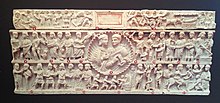|
Sarcophagus of Adelphia The Sarcophagus of Adelphia is an early Christian, circa 340 AD sarcophagus now in the Museo Archeologico Regionale Paolo Orsi in Syracuse, region of Sicily, Italy.[1] The sarcophagus was found in the Rotunda of Adelphia inside the Catacombs of San Giovanni, in Siracusa. The iconography displayed has similarities to the layout of the Dogmatic and Junius Bassus sarcophagi, although the quality of to depictions is simplified. Description The name of the sarcophagus derives from the hypothesis that it was used for the burial of the Roman noblewoman Adelfia. The central medallion would represent a portrait of the couple, mentioned in the center of the lid by an epigraph arranged on three lines in a tabula ansata on a red background: (H)IC ADELFIA C(LARISSIMA) F(EMINA) POSITA CONPAR BALERI COMITIS Here lies Adelphia, famous woman, wife of Count Valerius.
In the upper lid are likely four episodes, two likely regarding the life of Mary on the left, and two depicting events surrounding the Nativity, including the three Magi following the star of Bethlehem. It also contains a plaque identifying Adelphia and her spouse Valerius. The second register has eight episodes, four on each side of the central shell with the married couple. On the left, from left to right, are scenes depicting:
On the right are scenes depicting
In the third (lowest) register, are scenes depicting:
Adelphia and ValeriusAccording to the inscription, Adelphia was the wife of a Count Valerius. According to recent studies, Valerius was the friend of St. Augustine cited in the Introduction of the De nuptiis et concupiscentia (“About marriage and lust”).[3] References
|